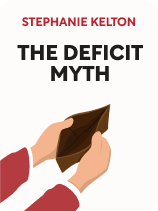

This article is an excerpt from the Shortform book guide to "The Deficit Myth" by Stephanie Kelton. Shortform has the world's best summaries and analyses of books you should be reading.
Like this article? Sign up for a free trial here .
Is national debt a problem in the United States? Why does Stephanie Kelton believe that government officials are promoting debt hysteria?
Stephanie Kelton is an economist, a believer of modern monetary theory, and the controversial author of The Deficit Myth. In her book, she argues that there is no threat from the national debt and that conversations surrounding the United States debt are full of fearmongering.
Continue reading to learn why Kelton thinks the United States could wipe its debt at any time.
There’s No Threat From the National Debt
Stephanie Kelton writes that fearmongering about the U.S. national debt has long been a staple of political discourse. Politicians from both major parties seem to be constantly hyping the danger from the debt—that it threatens to eat us alive with escalating borrowing costs, that it constitutes a mortgaging of the country’s future, and that we’ll never be able to pay it back without either significant tax increases (Democrats’ preferred solution) or massive budget cuts (Republicans’ preferred solution).
But Kelton argues that this debt hysteria is both factually wrong and counterproductive for the nation’s economic health. In reality, the national debt poses no threat.
| Is the Debt-to-GDP Ratio a Threat to the Economy? Is national debt and its ratio to GDP a problem? Many economists have argued that the threat from the national debt is very real, and can even be precisely quantified. In a famous 2010 paper, Harvard economists Carmen Reinhart and Kenneth Rogoff argued that there was a specific threshold of debt-to-GDP above which a nation’s economy would begin to stagnate. They were particularly focused on the portion of the national debt owed to foreign creditors. Reinhart and Rogoff argued that once a nation’s debt-to-GDP ratio reach 60%, it could expect to see annual growth decline by 2%. Once it reached 90%, that country’s expected GDP growth would be cut in half—although it’s worth noting that the U.S. debt-to-GDP ratio in 2021 stood at 125% and has consistently been over 90% for over a decade, and nothing like what Reinhart and Rogoff predict has come to pass. The Reinhart-Rogoff theory exerted significant influence over the policy views and actions of center-right governments during the 2010s, who claimed that social spending needed to be slashed in order to bring the debt ratio under control and avoid economic stagnation. |
U.S. Debt: The Cornerstone of Global Finance
Kelton notes that American national debt is created through the sale of U.S. Treasury bonds. Because the federal government can never default on these bonds (because it has monetary sovereignty that enables it to always create the dollars it needs to make the interest payments), they are considered risk-free securities.

———End of Preview———
Like what you just read? Read the rest of the world's best book summary and analysis of Stephanie Kelton's "The Deficit Myth" at Shortform .
Here's what you'll find in our full The Deficit Myth summary :
- A look at national debt through the lens of Modern Monetary Theory
- How public discourse about national debts and deficits gets the facts wrong
- Why MMT says the U.S. government could finance any program it wishes to create






